Voice frequency subscriber interface (analogue telephone line)
Application:
Voice frequency subscriber interface is an interface realizing a two-wired duplex baseband analogue connection.
Interface consists of two transceiver circuits and 2 metallic local lines, connecting them.
Its main application field: attaching analogue telecommunication terminals to the exchanges in the local network.
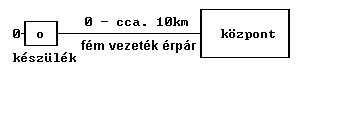
The following figure demonstrates the attachment of an analogue telecommunication terminal to a SPC exchange:
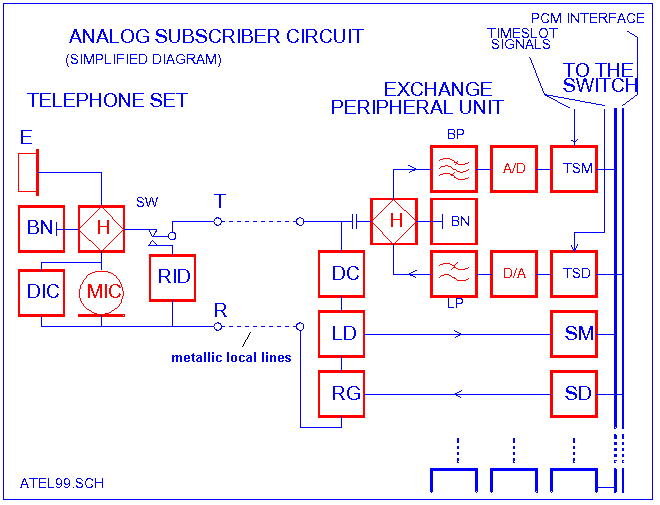
Legend:
- E - receiver
- MIC - microphone
- H - hybrid an eight-pole (bridge connection) for separartion of the two directions of signal transmission
- BN - (Balanced Network) equalizer circuit for realization of the bridge equalization in the hybrid circuit
- RID - Ringer
- DIC - Dial or dialing buttons for giving signals (with pulse or voice frequency - DTMF)
- BP - a band filter for constraining the bandwidth of the channel (between 300 and 3400 Hz -
this is enough for an understandable speech transmission) and for the elimination
of the signal lapstreak.
- A/D - analogue-digital converter (PCM codec) sampling (8 kHz) nonlinear quantization,
coding of samples to 8-bit bit serial codewords (G.711 Alaw).
- TSM - timeslot multiplexer (inserts the code words to a timeslot of the PCM frame)
- TSD - timeslot demultiplexer (takes out the code words from a timeslot of the PCM frame)
- D/A - digital analogue converter (converting code words back to sampless)
- LP - low pass filter (converting the samples to a continouos time signal)
- DC - feeding bridge (provides equipment with current)
- LD - (Loop detector) current detector (perception of signals of the subscriber ? closing/stopping of feeding current).
- RG - ringing generator (25 Hz cca. 70V)
- SM - signal multiplexer (insertation of the subscriber signal to the PCM signal flow, and its forwarding towards the processor of the exchange)
- SD - signal demultiplexer (taking out the signal from the PCM frame arriving from the processor of the exchange)
Services:
- Ability of duplex signal transmission. Separation of direction in the equipment - and if it is necessary, in the exchanges - will happen with the help of hybrid circuits.
- Remote feeding of subscriber equipment.
- Ability of signal transmission. Transmission of signals of the equipment and the exchange. These signals could be:
signals above the speech band (tariff impulses of 12-16 kHz-s)
Interface topology:
- Interface realizes a point-to-point connection.
- Elongation of the interface happens with line extensions.
Data changing wires:
- For realizing this interface a symmetric metal transmission medium is necessary,
which has voice frequency band transmission bandwidth. Marking of the string pair is in Europe "a" and "b", and "T" and "R" in America. (One of the wires joins to the tip of the plug of the hand-switch exchange, and the other one joins to the connection cod ring.
Electrical characteristics:
- Voice frequency transmission bandwidth .
- An impedance of 600 ohm
Technical data:
Main data of the copper subscriber cables:
| Conductor diameter | Resistance | Capacity | Attenuation
|
|---|
| mm | ohm/km | nF/km | dB/km 800 Hz-en
|
|---|
| 0.4 | 280 | 50 | 1.6
|
|---|
| 0.6 | 125 | 51 | 1.1
|
|---|
| 0.8 | 73 | 53 | 0.85
|
|---|
Mechanical characteristics:
Widely used connector is the RJ-11 type of "telephone" connector on the terminal-side:
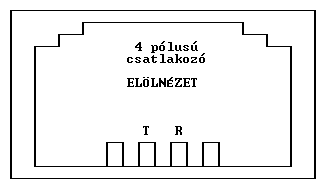
Cables are connected to the getter of the exchange on the exchange-side.
Interface processes:
Protocol of set-up and release of a connection:
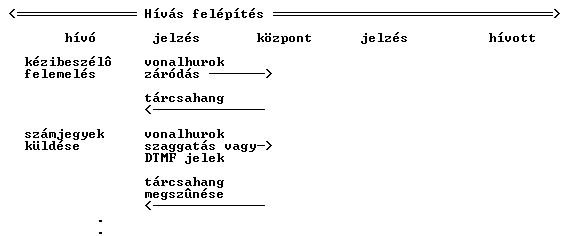
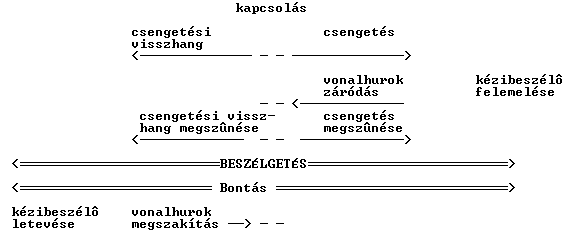

Remote feeding:
- Feeding the equipment from the exchange from 48Vs of direct current, through a feeding bridge.
- a-branch + /earth/
- b-branch - 48V
- Typical value: 50 mA
- Minimal value: 20 mA
- Maximal value: 60 ... 80 mA
- Direct current resistance of the equipment: 200 ... 400 ohm
- Resistance of the subscriber loop (line + equipment): 1000 ... 2000 ohm
Closing the interface with an equipment:






